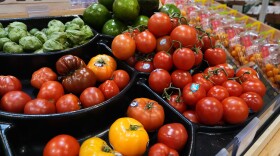The Sunshine State’s rays can be blocked out by wildfire smoke at any point during the year in Florida and right now, in early January, Southwest Florida is the driest part of the state.
A burn ban has been in place since June in Lee County, and water-use restrictions are active in Cape Coral, and on Sanibel and Captiva islands.
A Florida Forest Service map, which identifies the areas most likely to burn anytime soon, has the tell-tale bright yellows and oranges in a swath stretching south from coastal Sarasota County through DeSoto and Lee counties.
One cold front after another is reaching deep into South Florida this month with high winds and rain, but the cold and windy air also increases evaporation that turns wet leaves and branches dry and more apt to burn should a wildfire get started.
Related story
Then, before April showers can turn to May flowers, January’s chilly weather is expected to mellow after February to allow for an early-season warm-up come March when the wildfire risk is predicted to rise in the region even more.
“We're in a weird weather pattern,” Michael Harris, a wildfire mitigation specialist with the Florida Forest Service in Fort Myers, said. “Right now, for the next two months, it's average because of the drier weather. But that doesn’t preclude the chance of having a local, you know, a severe fire right now.”
Warmer, wetter; colder, drier
The back-and-forth between wetter and warmer and colder and drier has been happening since hurricane season. Saturated ground and sopping-wet underbrush were a legacy of Helene and Milton when the hurricanes combined to drop more than a foot of rain in September and October. Now, three months later, some of the same woods are tinder dry due to the windy cold fronts.
The only certainty this year is continual weather changes in the forecastable future, which is making it difficult to predict the spring wildfire season.


The state forest service is continuing with its program of controlled burns, where wildland fire specialists light little fires to prevent larger ones from taking hold when it’s drier. A big focus in Southwest Florida for the controlled burns is the Big Cypress National Preserve, which has issued a temporary closure in certain areas of the preserve for planned fires this week.
The closure includes all areas and trails within the treatment perimeter, trails on the perimeter of the unit will remain open for use. During the closure all recreational use including off-road vehicles, hiking, camping, hunting and commercial activities are prohibited in the designated areas.
Last May, there was a 10,000-acre wildfire in Big Cypress that took firefighters weeks to put out due to the dry conditions at the time and the remote location of the blaze.
That Southwest Florida is dryer than other parts of the state right now is reflected in a tool wildland fire forecasters use called the Keetch-Byram drought index, which uses a scale from zero to 800 to measure how thirsty the soil is. Dry soil means more fuel for flames.
Because “zero” most often means none of something, and a larger number like 800 normally indicates more of something, at first glance the scale is arguably counter-intuitive. The KBDI measures the lack of moisture in the ground, which means zero is mud-pie-wet soil and 800 is Saharan-desert-parched.
The KBDI in Southwest Florida this week has been hovering over 500 from Sarasota south to Lee counties and in the 400s otherwise, except for Collier County where the ground is rather moist.
Fire weather concerns
The National Interagency Coordination Center may be in Boise, Idaho, but it predicts wildfire activity throughout the nation by region and also coordinates and mobilizes resources to fight wildland fires should a state need extra resources and other incidents throughout the United States.
Like Florida Forestry’s Michael Harris, the Boise-based center is predicting Southwest Florida will have an above-normal potential of wildfire in March and April when temperatures are expected to be higher than normal, but warns a woodland fire “could” happen anytime.
However, the cold fronts plummeting into Florida this month do not preclude wildfire. Despite it being chilly, an unwatched campfire or train shooting off sparks into the underbrush when braking could ignite a one-off blaze due to “strong winds accompanying any dry fronts that pass through will lead to elevated fire weather concerns at times.”
Sign up for WGCU's monthly environmental newsletter, the Green Flash, today.
WGCU is your trusted source for news and information in Southwest Florida. We are a nonprofit public service, and your support is more critical than ever. Keep public media strong and donate now. Thank you.








